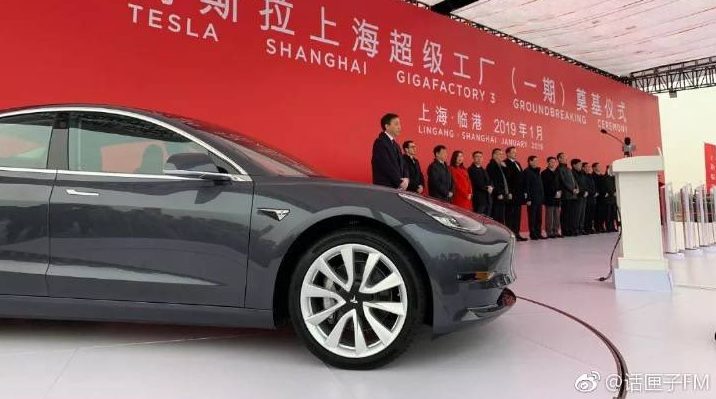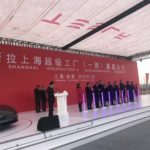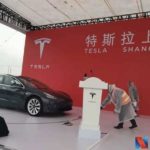

News
Tesla Gigafactory 3 in China to exclusively produce Model 3 and Model Y variants
Tesla’s groundbreaking event for Gigafactory 3 showcased the company’s current lineup of vehicles and a personal appearance from CEO Elon Musk. As could be seen from images uploaded of the ceremony, Musk shared the stage with the first vehicle expected to be produced in the upcoming facility — a Tesla Model 3.
Unlike Tesla’s first Gigafactory in Nevada, which produces the Model 3’s drive units and battery packs, Gigafactory 3 is set to be equipped with production lines for both batteries and electric cars. As confirmed by Elon Musk earlier today prior to the facility’s groundbreaking ceremony, the Shanghai facility will be producing the Model 3 sedan and the Model Y SUV.
In a follow-up tweet, though, Musk also mentioned a particularly notable detail about Gigafactory 3’s output. In his update, Musk stated that the upcoming Shanghai facility would be exclusively producing “affordable” versions of the Model 3 and Model Y. Higher-end versions of the vehicles, such as the Model 3 Performance, would still be built in the United States and exported to international markets, including China.
Shanghai Giga will produce affordable versions of 3/Y for greater China. All Model S/X & higher cost versions of Model 3/Y will still be built in US for WW market, incl China.
— Elon Musk (@elonmusk) January 7, 2019
Such an announcement bodes well for Tesla’s strategy in the Asian economic superpower. Tesla’s vehicles in the country, after all, have so far been higher-priced than EVs produced by local electric car makers. By producing its lower-end Model 3 and Model Y in Gigafactory 3, Tesla would be able to price the vehicles very competitively in the country, mainly as the electric cars would not be subject to import taxes — regardless of the presence of a trade war between the United States and China.
Elon Musk has not provided more details about the “affordable” versions of the Model 3 and Model Y that would be produced in Gigafactory 3. In the case of the Model 3, though, Musk’s statement most likely pertains to the Standard Range version of the electric sedan. That’s a car that is, at its most basic iteration, priced in the United States in the same range as a top-tier Toyota Camry. The Tesla Model Y, on the other hand, is an electric car that would be competing in a market already enamored with SUVs. In China, a country that is aggressively pushing for the adoption of electric vehicles, such electric cars would likely be disruptive.
- (Photo: TeslainShanghai/Imgur)
- (Photo: TeslainShanghai/Imgur)
- (Photo: TeslainShanghai/Imgur)
Images from Tesla’s Gigafactory 3 groundbreaking event in Shanghai, China. (Photo: TeslainShanghai/Imgur)
Tesla is aiming to follow an incredibly ambitious timetable for Gigafactory 3. When the company initially announced its target of starting vehicle production within two years after the facility begins construction, many in the United States were skeptical. Wall Street analyst James Albertine, for one, flat-out declared the target timeline was “not feasible.” In Tesla’s Q3 2018 production and deliveries report, Tesla did adjust its estimates, making its timetable even more aggressive. Earlier today, Musk noted on Twitter that the goal is to finish the initial construction of Gigafactory 3 this summer, followed by the start of Model 3 production by the end of 2019. Large-scale manufacturing of the electric sedan would begin sometime next year.
While such an aggressive timeline is classic Elon Musk, it should be noted that Tesla seems to be getting a considerable amount of support from the Chinese government. After the project was officially announced last year, for example, it did not take long before local Shanghai banks granted Tesla low-interest loans to fund part of the facility’s construction. Furthermore, Tesla’s bid for the 864,885-square meter plot of land in Shanghai’s Lingang Industrial Zone went unchallenged. The company’s construction partner, China Construction Third Engineering Bureau Co., Ltd, is also a subsidiary of China Construction, which is owned by the government.
With support from the local Chinese government, there is almost no doubt that Gigafactory 3 will be completed on schedule. Ultimately, the start of Model 3 production in the upcoming facility would likely depend on Tesla’s capability to ship and set up its equipment in the battery and electric car factory.
Watch Elon Musk’s speech at the Gigafactory 3 groundbreaking ceremony in the video below.

Elon Musk
Elon Musk and Tesla AI Director share insights after empty driver seat Robotaxi rides
The executives’ unoccupied tests hint at the rapid progress of Tesla’s unsupervised Robotaxi efforts.

Tesla CEO Elon Musk and AI Director Ashok Elluswamy celebrated Christmas Eve by sharing personal experiences with Robotaxi vehicles that had no safety monitor or occupant in the driver’s seat. Musk described the system’s “perfect driving” around Austin, while Elluswamy posted video from the back seat, calling it “an amazing experience.”
The executives’ unoccupied tests hint at the rapid progress of Tesla’s unsupervised Robotaxi efforts.
Elon and Ashok’s firsthand Robotaxi insights
Prior to Musk and the Tesla AI Director’s posts, sightings of unmanned Teslas navigating public roads were widely shared on social media. One such vehicle was spotted in Austin, Texas, which Elon Musk acknowleged by stating that “Testing is underway with no occupants in the car.”
Based on his Christmas Eve post, Musk seemed to have tested an unmanned Tesla himself. “A Tesla with no safety monitor in the car and me sitting in the passenger seat took me all around Austin on Sunday with perfect driving,” Musk wrote in his post.
Elluswamy responded with a 2-minute video showing himself in the rear of an unmanned Tesla. The video featured the vehicle’s empty front seats, as well as its smooth handling through real-world traffic. He captioned his video with the words, “It’s an amazing experience!”
Towards Unsupervised operations
During an xAI Hackathon earlier this month, Elon Musk mentioned that Tesla owed be removing Safety Monitors from its Robotaxis in Austin in just three weeks. “Unsupervised is pretty much solved at this point. So there will be Tesla Robotaxis operating in Austin with no one in them. Not even anyone in the passenger seat in about three weeks,” he said. Musk echoed similar estimates at the 2025 Annual Shareholder Meeting and the Q3 2025 earnings call.
Considering the insights that were posted Musk and Elluswamy, it does appear that Tesla is working hard towards operating its Robotaxis with no safety monitors. This is quite impressive considering that the service was launched just earlier this year.
Elon Musk
Starlink passes 9 million active customers just weeks after hitting 8 million
The milestone highlights the accelerating growth of Starlink, which has now been adding over 20,000 new users per day.

SpaceX’s Starlink satellite internet service has continued its rapid global expansion, surpassing 9 million active customers just weeks after crossing the 8 million mark.
The milestone highlights the accelerating growth of Starlink, which has now been adding over 20,000 new users per day.
9 million customers
In a post on X, SpaceX stated that Starlink now serves over 9 million active users across 155 countries, territories, and markets. The company reached 8 million customers in early November, meaning it added roughly 1 million subscribers in under seven weeks, or about 21,275 new users on average per day.
“Starlink is connecting more than 9M active customers with high-speed internet across 155 countries, territories, and many other markets,” Starlink wrote in a post on its official X account. SpaceX President Gwynne Shotwell also celebrated the milestone on X. “A huge thank you to all of our customers and congrats to the Starlink team for such an incredible product,” she wrote.
That growth rate reflects both rising demand for broadband in underserved regions and Starlink’s expanding satellite constellation, which now includes more than 9,000 low-Earth-orbit satellites designed to deliver high-speed, low-latency internet worldwide.
Starlink’s momentum
Starlink’s momentum has been building up. SpaceX reported 4.6 million Starlink customers in December 2024, followed by 7 million by August 2025, and 8 million customers in November. Independent data also suggests Starlink usage is rising sharply, with Cloudflare reporting that global web traffic from Starlink users more than doubled in 2025, as noted in an Insider report.
Starlink’s momentum is increasingly tied to SpaceX’s broader financial outlook. Elon Musk has said the satellite network is “by far” the company’s largest revenue driver, and reports suggest SpaceX may be positioning itself for an initial public offering as soon as next year, with valuations estimated as high as $1.5 trillion. Musk has also suggested in the past that Starlink could have its own IPO in the future.
News
NVIDIA Director of Robotics: Tesla FSD v14 is the first AI to pass the “Physical Turing Test”
After testing FSD v14, Fan stated that his experience with FSD felt magical at first, but it soon started to feel like a routine.

NVIDIA Director of Robotics Jim Fan has praised Tesla’s Full Self-Driving (Supervised) v14 as the first AI to pass what he described as a “Physical Turing Test.”
After testing FSD v14, Fan stated that his experience with FSD felt magical at first, but it soon started to feel like a routine. And just like smartphones today, removing it now would “actively hurt.”
Jim Fan’s hands-on FSD v14 impressions
Fan, a leading researcher in embodied AI who is currently solving Physical AI at NVIDIA and spearheading the company’s Project GR00T initiative, noted that he actually was late to the Tesla game. He was, however, one of the first to try out FSD v14.
“I was very late to own a Tesla but among the earliest to try out FSD v14. It’s perhaps the first time I experience an AI that passes the Physical Turing Test: after a long day at work, you press a button, lay back, and couldn’t tell if a neural net or a human drove you home,” Fan wrote in a post on X.
Fan added: “Despite knowing exactly how robot learning works, I still find it magical watching the steering wheel turn by itself. First it feels surreal, next it becomes routine. Then, like the smartphone, taking it away actively hurts. This is how humanity gets rewired and glued to god-like technologies.”
The Physical Turing Test
The original Turing Test was conceived by Alan Turing in 1950, and it was aimed at determining if a machine could exhibit behavior that is equivalent to or indistinguishable from a human. By focusing on text-based conversations, the original Turing Test set a high bar for natural language processing and machine learning.
This test has been passed by today’s large language models. However, the capability to converse in a humanlike manner is a completely different challenge from performing real-world problem-solving or physical interactions. Thus, Fan introduced the Physical Turing Test, which challenges AI systems to demonstrate intelligence through physical actions.
Based on Fan’s comments, Tesla has demonstrated these intelligent physical actions with FSD v14. Elon Musk agreed with the NVIDIA executive, stating in a post on X that with FSD v14, “you can sense the sentience maturing.” Musk also praised Tesla AI, calling it the best “real-world AI” today.











